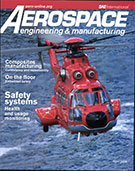Technical Paper
Enhancement of 6M Methodology as a Design for Assembly Tool for Developing Effective Aerostructures Assembly Process Designs
2021-08-27
2021-01-6001
Aerostructures assembly (ASA) is a vital process in any aircraft production phase that integrates individual detail parts, sub-assemblies, major assemblies, components, and systems into a final deliverable, a completed aircraft structure fit for flight. ...ASA depends on highly skilled manual labor work across the global aerospace supply chain for various assembly processes and subprocesses required for assembling detail parts into sub-assemblies and components to achieve the design intent of the load-carrying aerostructure that is airworthy for the complete operational cycle till disposal of an aircraft. ...The 6M enhanced framework is used to create as a process design tool, and the outputs of the research are converted in assessment guidelines, which were validated by a global aerospace accreditation body for its adoption in the aerostructures supply chain. This paper can also be used as a reference guide by ASA engineers to readily identify the factors that can impact any process, ensuring the highest quality and reliable aerostructures products to customers ensuring cost-effective On-Time Delivery (OTD).







